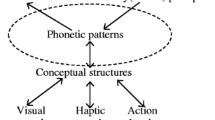Abstract
The present article examines the role of imagery in the solution of linear syllogisms and attempts to bring about a resolution between previous theories based on imagery and those based on linguistics. Syllogisms rated by subjects as evoking high imagery are solved faster and more accurately than those rated as evoking low imagery. In some cases, regarding the conflicts between imagery and linguistic theories, both theories are supported, depending on whether one uses error rate or latency as the measure of difficulty. This discrepancy is resolved by suggesting that imagery theory is more of a theory of problem solving and is best examined through the measure of error rate. Linguistic theory is more a measure of sentence processing and is best measured using latencies. This is supported by the use of syllogisms which control for linguistic parameters. In such cases, predictions of imagery theory are supported. The two opposing theories are probably more complementary than oppositional.
Similar content being viewed by others
References
Bierwisch, M. (1973). Semantics. In Lyons, J. (ed.),New Horizons in Linguistics, Penguin Books, Baltimore.
Caramazza, A., Gordon, J., Zurif, E., and DeLuca, D. (1978). Right hemispheric damage and problem solving behavior.Brain Lang. (in press).
Clark, H. (1969). Linguistic processes in deductive reasoning.Psychol. Rev. 76:387–404.
Clark, H. (1971). More about “Adjectives, comparatives and syllogisms”: A reply to Huttenlocher and Higgins.Psychol. Rev. 78:505–514.
Deese, J. (1965).The Structure of Associations in Language and Thought, Johns Hopkins Press, Baltimore.
DeSoto, C. (1961). The prediliction for single orderings.J. Abnorm. Soc. Psychol. 62:16–23.
DeSoto, D., London, M., and Handel, S. (1965). Social reasoning and spatial paralogic.J. Personal. Soc. Psychol. 2:513–521.
Greenberg, J. (1966).Language Universals: With Special Reference to Feature Hierarchies, Mouton, The Hague.
Handel, S., DeSoto, C., and London, M. (1968). Reasoning and spatial representations.J. Verb. Learn. Verb. Behav. 7:351–357.
Henley, N., Horsfall, R., and DeSoto, C. (1969). Goodness of figure and social structure.Psychol. Rev. 76:194–204.
Hunter, I. (1957). The solving of three term series problems.Br. J. Psychol. 48:286–298.
Huttenlocher, J., and Higgins, E. (1971). Adjectives, comparatives, and syllogisms.Psychol. Rev. 78:487–504.
London, M. (1966). Directionality of ordering. Doctoral dissertation, Johns Hopkins University, University Microfilms No. 66-12, 496.
Lyons, J. (1968).Introduction to Theoretical Linguistics. Cambridge University Press, Cambridge.
Marshall, J. (1969). Psychological aspects of semantic structure. In Meetham, A. R. (ed.),Encyclopaedia of Linguistics, Information and Control, Pergamon, Hungary.
Paivio, A. (1969). Mental imagery in associative learning and memory.Psychol. Rev. 76:241–263.
Paivio, A. (1971). Imagery and deep structure in the recall of English nominalizations.J. Verb. Learn. Verb. Behav. 10:1–12.
Paivio, A., Yuille, J., and Madigan, S. (1968). Concreteness, imagery and meaningfulness values for 925 nouns.J. Exp. Psychol. Monogr. Suppl. 76:1–25.
Sapir, E. (1944). Grading, a study in semantics.Phil. Sci. 11:93–116.
Thorndike, E., and Lorge, I. (1944).The Teacher's Word Book of 20,000 Words, Columbia University, New York.
Author information
Authors and Affiliations
Rights and permissions
About this article
Cite this article
Williams, R.L. Imagery and linguistic factors affecting the solution of linear syllogisms. J Psycholinguist Res 8, 123–140 (1979). https://doi.org/10.1007/BF01067487
Received:
Issue Date:
DOI: https://doi.org/10.1007/BF01067487




